Text
whose tenement house?

[This opinion piece was originally written in 2018, as part of a student initiative at the University of Glasgow. I am publishing it again in a time where having a safe home feels more significant than ever.]
It’s a (miraculous) sunny Wednesday morning in August, and I am meeting my friend at St George’s Cross station. Together, we head East, crossing the pedestrian bridge arching above the busy M8. Our destination: Buccleuch Street. Over the last four years, I’ve walked the streets of this city back and forth, moved five times, visited dozens of student flats in the most humid corners of my neighbourhood, and taken a myriad of pictures of the characteristic Glaswegian building facades. And yet! It has taken me all this time to set foot in the Tenement House.
Before I begin the tale of my latest Glaswegian discovery, let me set some definitions straight. The Scotland Tenement Act of 2004 defines a tenement as a “traditional sandstone [building] of between 2 and 5 storeys in height constructed between 1840 and 1920, found within the city centre and the original former burghs annexed by Glasgow in the late 19th and early 20th centuries.” A tenement can refer to the building as a whole; a tenement house, however, is specifically a flat within a building.
The Tenement House is a museum about the tenements that make up the architectural landscape of many Glaswegian boroughs. It’s a slice of the 1920s neatly conserved in a period-appropriate tenement flat; a personal collection of objects, former property of hand typist Miss Agnes Toward, now in the hands of the National Trust. As you walk in on the ground floor, there is a small exhibition providing insight on the living conditions of the people of Glasgow in Miss Toward’s time. How the tenement buildings were built, who lived in them, who was Miss Toward, and what kind of life did she lead. Spoiler alert: it was a quiet existence. The few rooms on the ground floor set a context for the real show that takes place upstairs, on the first floor.
It smells of gas as you walk into the square and spacious hallway. The traditional gas lamps are lit, and yet it’s a little dark, even in full day light. On one side, the kitchen and bathroom, on the other, the living room and bedroom. It’s a classic Glasgow city flat layout. The bathroom is long and narrow, with bathtub, sink and toilets lined up on the right, and the walls are bordered with wooden panels. I’ve seen this bathroom before, coated with white or pastel paint for a slightly more modern look. In the kitchen, I also recognise the wooden drying racks hissed high under the ceiling thanks to a robust cord mechanism. I used to have the same system, in my flat on Otago Street. And there, in one corner of the room, there’s even the same rectangular nook, in which my former flatmates and I had put our dining table. Except in this instance, a double bed is lodged there. The tour guides explain that this was a pretty common sight. Large families lived in these one-bedroom flats, so of course extra bedding was necessary; the kitchen was a good candidate for a sleeping nook, because it was always warm. The living room also has one, except it looks more like a cupboard, with its door for ‘privacy’. How handy. Otherwise, the lounge has fairly standard features. Fireplace? Check. Bay window? Check. High ceilings with a rose and other fancy fixtures? Check and check. As for the bedroom, it fits the same bill.
I look around the flat, and what strikes me most is that, furniture and wallpaper aside, this space isn’t much different from other modern-day tenements I’ve seen in my student neighbourhood. Well, I suppose time has brought technology, and with it some updates, in theory. Electricity and safe gas, separate bedrooms for everyone – all things we now have good reasons to call common necessities. Except. Not so long ago two friends of mine lived in a flat in Ibrox that didn’t have gas, so their heating was comprised of two electric radiators and the warmth of the kitchen hob. I used to rent a flat that had a top-up meter for gas and electricity. Run out of credit, run out money, and you’ll watch the entire flat shut down. At the time, none of us are from the UK and therefore haven’t built credit yet. So when we try to get a monthly meter put in place: access denied. As for separate bedrooms? I’ll admit that, apart from the occasional couple sharing a room, these are most often granted. But living rooms aren’t. In the West End at least, it’s more profitable to turn a two-bedroom flat with lounge and kitchen into a three bedroom with a sofa dumped in a corner of the dining kitchen. We look at these cupboards suited for double beds, and we ask ourselves: How strange, that people lived like this. Sleeping in the living room? Isn’t that insane?
The parallel might sound silly, but it doesn't just stop there. When the age of the tenements began, one company would build and own an entire block of buildings. From the start, this set up a power imbalance between offer and demand, landlords and tenants. Aided by the industrial rush, landlords had close to no problem filling their properties with tenants, cramming large families into two-bedroom flats, so they barely troubled themselves with embellishing the tenements houses. This led to a quick degradation of people’s living conditions, as necessary property repairs caused by wear and tear weren’t carried out. But with numerous working families in need of places to stay and lacking the buying power to acquire property, the overall quality of the tenements made no difference. The renting market was to property owners what a twenty years of age carpet is to dust mites; a gold mine.
Now you might think we have moved past this, as the concept of ‘climbing the property ladder’ is one of the building blocks of the successful middle-class British story. But going back to the portrait of modern-day Glasgow, I see more of a nuance in shade than an actual contrast in colour. Who doesn't know the urban legend of the Glasgow millionaires? The privileged few who own close to entire blocks in the city and drive around in their roaring convertibles on sunny days. My former landlord was one of them, and me, my flatmate, and our single-glazed, lightly wooden-framed windows never caught sight of him. There is still only a minority of landlords, who have no trouble renting out their flats from year to year, and landlords who don’t carry out heavy refurbishment works even when the property is falling apart. There is still a large demand, with the number of West End residents in Glasgow increasing every year that the University of Glasgow gains a rank in the League Tables. And there are still people in need of a roof over their head, who will pay what it takes to get it, regardless of the condition of the property.
The comparison doesn’t stop there. The facades of tenement buildings are physical reminders of the class stratification of the 1920s. Pick up on specific features and you will guess the type of people who used to live in your block. Stain glass windows in the common staircase or on bay windows were a sign of wealth. As for these building corridors covered in tiles that might remind you of old-fashioned subway stations, they’re basically a physical representation of the social hierarchy. Coloured tiles covering the walls from top to bottom mean upper middle class. Tiles covering about two-thirds of the walls in the staircase scream middle class. Half of the wall covered or no tiles at all signify a working class building.
Today, it’s no longer about tiles, but about window frames, as I briefly mentioned above. An entire building with double-glazed PVC windows and a well-kept facade is probably owned by families and rented by professionals. The wealth of the occupier is reflected on their windowpanes. Single glazing and paint chipping off the window frames in the middle of the Woodlands area hint at HMO rentals. Also spotted on the occasion is a flat with large cracks in the facade and windows held up by wooden poles. That one makes you angry and a little sad, because the building barely stands upright, but in the West End, you can still bet someone is paying £400 a month to rent a miserable room inside.

This might sound disproportionate to some. Overall living conditions have improved, so these issues may seem like privileged complaints. And I’ll grant it: despite these strange echoes of the 20s, we all manage to live decently; and yes, most of us students only stay in rentals two to three years on average. But this doesn't mean there is no room for improvement. Particularly since, despite having focused on the West End and my student reality in this essay, much more remains to be said about the quality of life in other areas of Glasgow further out East or South. In fact, in light of the technological advances of our time, the fact that a century has passed and that the most developed parts of Glasgow continue facing the same unchanged challenges is worrying. It is the sign of a renting crisis on a local scale, and of a much broader social crisis putting the most vulnerable at risk too. Just like living conditions quickly decayed in the 1920s, today’s Glasgow isn't exactly looking pretty. Around Charing Cross and Garnethill, streets harbour properties which clearly used to be high-end, upper class tenements. Close to St-George's Cross subway station, the Queens Crescent nests a private square, and looking at the street's architectural style, it was intended to be a rich area. But as you continue walking towards the M8, on the very way to the Tenement House I mentioned earlier, buildings in which people still live start to look more and more like urban ruins. The windows are paper thin, and the features that gave cachet to the sandstone are often falling to pieces. Looking at these buildings, it’s hard not to think that these flats will soon be beyond repair.
So perhaps the issue lies in how much money the city and its landlords can inject in their properties. But having seen rents rise from an average of £350 to £450 per person per month in the last three years, I remain dubious. I have first-hand experience of living right under a leaked roof, inheriting back problems from my spring mattress which sometimes left bruises on my skin, and living in a room where the window did not properly fit its frame, allowing freezing wind to sneak in during the winter. And yet - I have always been fairly lucky in my flat hunting endeavours. If I love the charming high ceilings and bay windows which allowed me to soak in some much-needed sunlight during the winter, I resent that the tenements have not been kept in better conditions.
In comparison to dreamy, well-kept Edinburgh, Glasgow is perceived to be dirty and rough. It's the people and their spirit that 'make' Glasgow. The endless walks through the wet Glaswegian streets have taught me otherwise. Of course, Glasgow has its own kind of magic. Glasgow has green paths and a riverfront. Glasgow has cathedrals and a social heritage written all over its cityscape. Ask anyone who has seen Glasgow on a sunny day in May, and they will tell you it is a sight to see, with its patchwork of architecture from all ages. Glaswegians are creative, they're welcoming, smart and conscious. They have initiative. They make you want to build a home right where they are. But if the people make Glasgow, why are they left dwelling in the same mess for decades, which are slowly stretching into hundreds of years? The Tenement House has been kept in an impeccable condition for a century and has succeeded in preserving this city's history and culture. So, I guess what it's left me asking is - what about our tenement houses?
#opinion piece#text#glasgow#scotland#tenement#tenement house#renting crisis#tenants#tenant rights#landlords#property market#architecture#glaswegian#history#scottish history#social cause#student life#student conditions#university of glasgow#student writing#essay#lisewithanl#glasgow west end#west end glasgow#society
16 notes
·
View notes
Text
czech mischiefs: a lived-in itinirary of three friends traveling through the czech republic.

Once upon a time, around the Christmas season, my two flatmates and I traveled to the Czech Republic. What follows is a chronological retelling of our wanders around Prague and the small town of Cesky Krumlov.
Protagonists: Lise L; Friend L; Friend C; Friend K; Friend A; Friend DK.
day one - night:
Departure from Glasgow at around 9pm, arrival in Prague at 11pm. Walk through the city streets to the hostel.
Friend L essentially decides she wants to move to Prague.
Check in: 12:30am
Bedtime: 1-1:30am
day two - day & night:
Breakfast at the hostel, Friend C adopts lonely planet guide.
Walk around the old town, bit of history on astronomical clock. We take in street architecture.
Jewish quarter discovery and emotional synagogue visits.
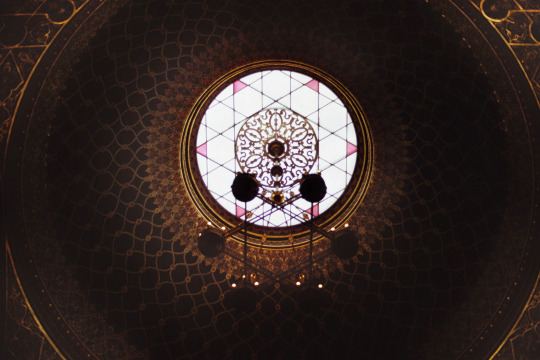
Coffee in café close to Kafka's house. Lunch at restaurant (pasta, salad, beer); turned grumpy Czech man into a smiling fellow, all the staff loved us.
Castle visit - the Halsburg's have ugly faces, thanks incest. Walk around the park and surrounding area. We feel grateful for our resistance to the rainy weather.
Stop at the Concert Hall on our way back to old town, we get student tickets for a quartet. Walk home, we buy bread at the breadshop for that night and the day after. Chaotic grocery shopping, in a tired state + dinner at the hostel.
Drink out with local Friend K in cool bar. Walk home at night, feeling peckish we bought a trdelnik - it was not a good one.
Bedtime: 1:00-1:30am.
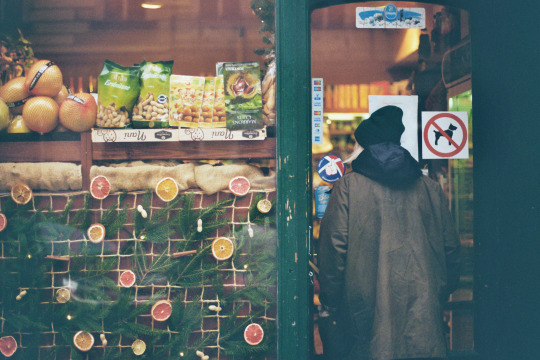
day three - day & night:
Breakfast upgrade at the hostel - We Made Our Own And We Are Great At Breakfast Making.
Walk around our neighbourhood in search of a café for L, who needs to do work. Visit to a bookshop where I find a children’s book on the city of Prague.
L finds plug adaptor in cannabis themed tourist shop. C and I go on our own adventure around the city.

Spotted: old camera shop.
Head down to Nové Město, to the Dancing House, through a park. Walk around the river Vltava, we get coffee in little place. Antique & second-hand bookshop visit where we find some great vintage prints and posters.
Walk along the other side of the river for a bit, then we cross what we assumed was Charles Bridge but really wasn't.
We stumble upon local market by the riverside, we get hot plum juice and buy a good portion of oyster mushrooms in hope of making omelette or open sandwiches that evening.

C and I head further down Nové Město, to the Botanic Gardens of the faculty.
We have our pre-packed snacks and lunch on a gardens bench. Lots and lots of laughing, followed by a random but well inspired tram journey back to old town.
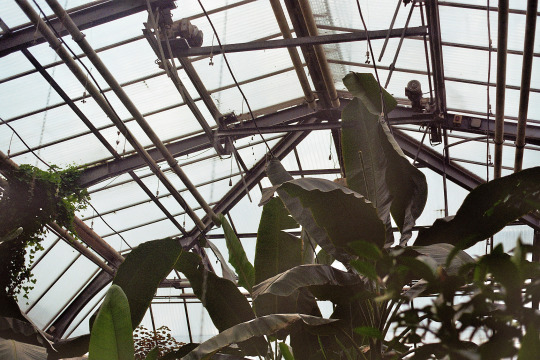
Stop at the National Theatre where we meet with L and K. Walk around dyzajn (read: design) market and then to the Christmas market. We take a break at Café Louvre with mulled wine - we taste meat broth.
Back to hostel for nap until 7:30pm. Meeting up with Friend A, who drives us to New Town, we have beers. He leaves and we go to another pub.
L goes home early, while C and I go on a mini pub crawl. We go to a random queer bar + u sudu. Sunny plays outside a kebab shop on the street, we rejoice. A long talk about everything and anything.
Walk home, where L is actually still awake.
Bedtime: 2am
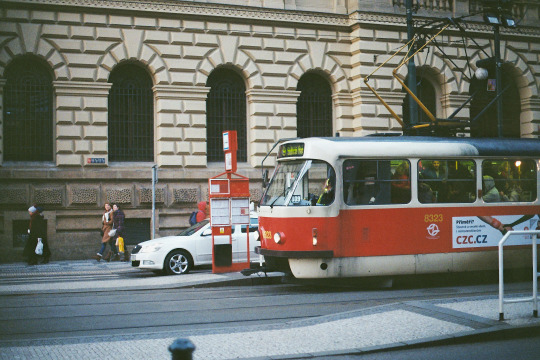
day four, day & night:
Breakfast at hostel + we pack our things (including mushrooms we still haven't cooked). Book bus tickets to Cesky Krumlov, we head out.
Bus at 11am, very comfy, we get free coffee included. L says she feels this trip is helping her take another step past her break up. C looks up our options for hostel and food places.
We get to Cesky Krumlov at 1-2pm, hungry. We take in the sights on our way in.
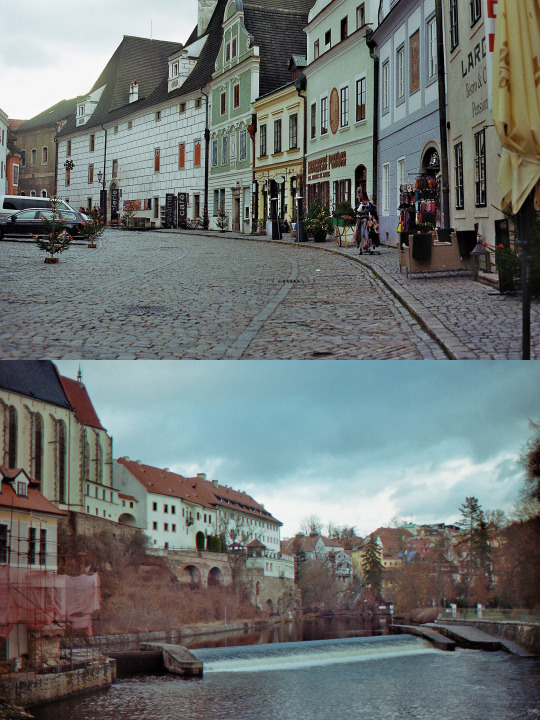
The Best Food Ever at local tavern: traut, fried cauliflower, fried cheese, potato pancakes, potatoes, veggies + kraut, beers, desert. Tavern staff loves us (again, we charm the local czech folks).
Muddy walk to hostel, L meets cat and is overwhelmed. Check in at Skippy's hostel (10/10, would recommend). Tea on the terrace by the river.

Down to Cesky Krumlov's centre, for Christmas market and town concert where Skippy plays. We get a proper Trdelnik and mulled wine, we are satisfied.
We follow the little theatre procession walking around town, along with children and chinese people. We explore the castle site at night, get nights view on town.
Small dinner at a warm vegetarian restaurant. Spanish people have dinner next to us and wonder where the meaty menu went. In the restaurant, C's alarm goes off endlessly and we only realise it's hers after 15 min.
We go back to the hostel, knackered, and fall asleep extra early.
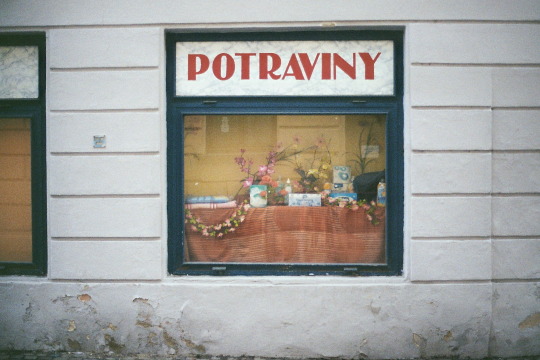
day five - day & night:
We wake up hungry but rested. We drink a great coffee by co-hostess
Walk to town centre, L says bye to the cat. We have breakfast at the Egon Shiele Cafe - it looks retro and cool. The museum is closed, C is a bit disappointed.
Walk around castle area from another part as the night before. L falls in stairs of old street. It hurts.
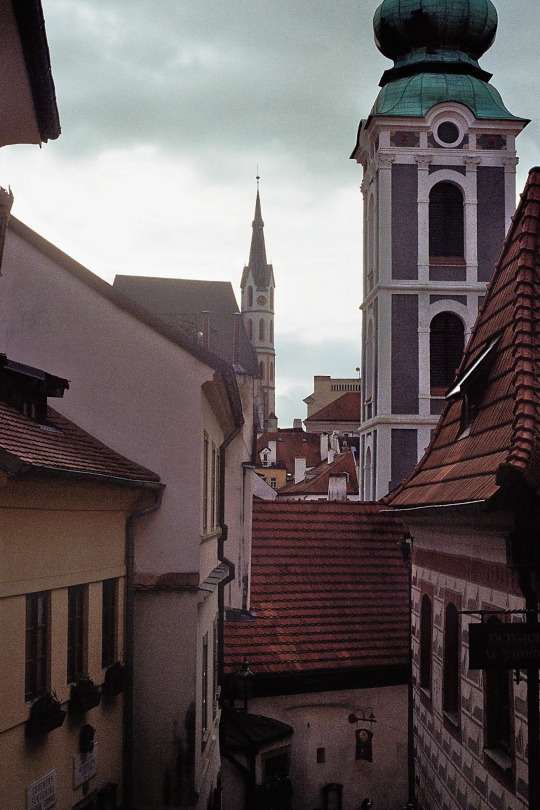
I buy wooden train for my niece in little boutique around the castle.
We get back to the hostel to pick up our things and take a rushed walk to the bus station, which ends under a light snow. We get to the bus and leave 2 min after. Get back to Prague at around 5:30pm.
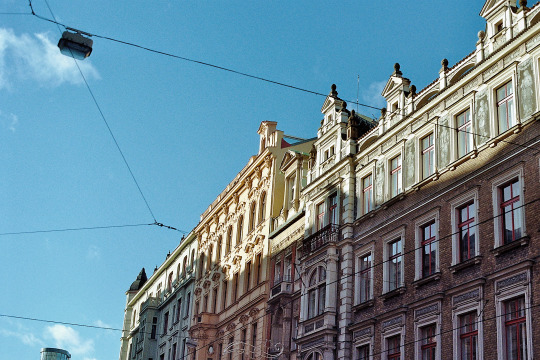
We take an illegally free tram to a new hostel in Holešovice. We get there later than we had hoped, but the place looks stunning.
We change and put away our things, then head straight out. We have twenty minutes to eat and then head to concert hall for the quartet. We find best place for tartines. So cheap and so good (ed. unfortunately this particular establishment is not listed online, but from memory it is situated at this street corner)
Then, we take yet another illegal tram to the Concert Hall. For full disclosure, I do not endorse this kind of behaviour and do not recommend as the public transport police is scary in Prague.
We make a run for the theatre and again get there a minute before the show starts, K is there already. The venue is gorgeous, we make a Czech woman smile.
Walk from concert hall to bar; K takes us on a spontaneous Places Where She Peed in Prague tour (highlight - the actual Charles Bridge); also a notable place - the park where all her boyfriends dump her (ed: K now dates girls and no longer gets dumped).
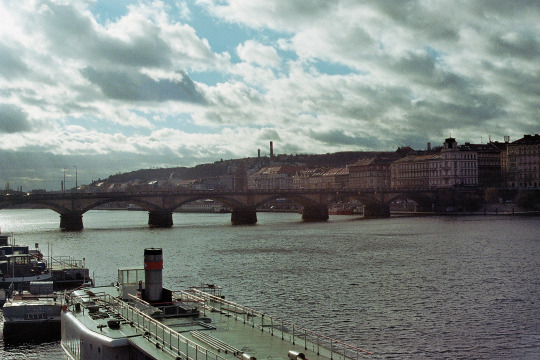
At tavern - Friend DK joins us for beers! Old Czech politician is present, he turned 82 a couple days before. He looks it.
We have wine, and beer, and absinth. DK leaves before absinth, it's a good thing. Drunk walk home. Takes us an hour.
Bedtime: 2am. We still haven't cooked the oyster mushrooms.

day six - day & night:
Breakfast at 9:30 in café not far from hostel (a hungover meal of sorts. Ish.) We hit a couple of second-hand shops, then we head to the Contemporary Art Museum in Holešovice.
L goes to meet some friends, C and I go for coffee, for what we will now start naming L and C's café crawl.
We stay in the neighbourhood with the vague goal to find a present for L's secret santa at last and go out in search of a market.

We go charity shopping - I get a dress and a top, C gets a jumper and acne skinny jeans in her size that L will later die of jealousy for.
We walk around just a little bit more, I buy film for my camera, we then stop at a cool art and design bookshop. We get free posters.
We get a cheap lunch in hip café. Soup + tortilla. C books a chaotic Blablacar for that very night.
Then, we make another stop in a bakery for desert and coffee. C has the pastry of a life time. I am over the moon about coffee.

We finally head to the market, walking. The market is dead. We start feeling the urgency of the ‘present’ situation (see what I did there). C and I comb the area around our hostel for present ideas. We walk through the most classically 2019, multipurpose, uberhip space to exist. To no one’s surprise, we find nothing there of our liking. Finally, we find a bookshop/café/wine place in the middle of a square, our heaven. We get cookbook for L + a pin of the Dancing House back at the hostel.
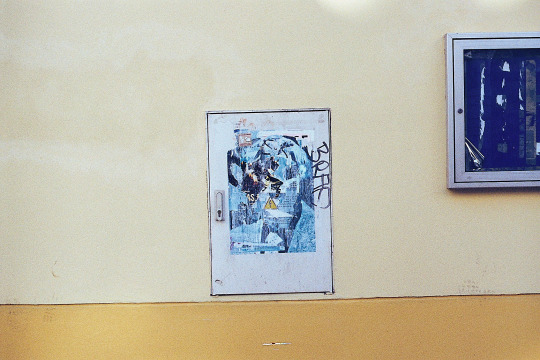
At the hostel, we meet L, buy stuff at the express supermarket and make dinner with the oyster mushrooms, at last.
We exchange secret santa gifts, C heads to her blablacar. L and I have a quiet night in, me packing for the next day, her sorting out her accommodation and plan for next few days as she is staying in Prague after us.
Bedtime: too early to matter.

day seven - day:
Wake up at 6:30am, departure from hostel at 7am, embarking on quite the transport trail.
Get to the airport at 8:15am.
Flight to Paris at 9:55am.
#prague#itinirary#trip#traveling#friends#czech republic#cesky krumlov#guide#photography#film photography#olympus om10#winter#christmas market#prague hostel#nove mesto#holesovice#stare mesto#rudolfinum#narodni galerie praha#prague guide#bohemia#cesky krumlov castle#travel#central europe#places#ramble
1 note
·
View note
Text
lise’s improvised kitchen #1 - shakshuka(ish).
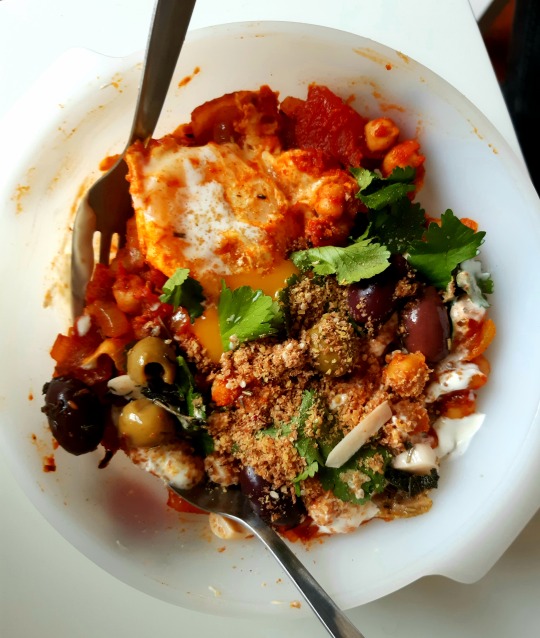
(or something resembling it. I don’t know, I’ve never set foot in Israel, so take this with a pinch of salt... or paprika)
Here is the thing about my cooking style: I don’t like to shop specifically according to a food plan. I don’t like having to conscientiously prep. I don’t like to follow recipes too long (in fact, I’m not sure I have the attention span to do that). In short, I like when there’s action, emotion and a little fire. I like to follow my instinct and see the kind of magic I can conjure (sometimes, it’s the dark, very dark kind). I like to bish bash bosh and somewhat, somehow, stumble upon something wow. I like when it goes in all kinds of directions but lands on its feet; I like the improvisation, the drama of it all.
Coming from this angle, you will understand I do not intend to deliver a thorough, succinct and methodical run down of my recipes. I will aim to make sense, at best. Neither will I claim that the dishes are culturally authentic or kitchen tested through and through. All I can guarantee is that I found the dish delicious, that I had the ingredients in the fridge, and that the result was easy enough to achieve with regular kitchen tools. Good enough for you? Ok. So. Edicion numero uno:
Shakshuka(ish)
> Slice an onion and the last shallot you have lying around (you have to use it at some point). If you have garlic, slice that as well. Drop them all in a large pan. Non-adhesive is better, if you benefit from this sort of kitchen technology.
> Drizzle in olive oil and add spices such as: cumin, curry, turmeric, za’atar, nutmeg, pepper, cayenne pepper, paprika, or/and rosemary. Whatever feels good, let it heat up in the pan.
> Once onions are soft, and the spices have overwhelmed your senses, open a handy can of chopped tomatoes and add it to your pan. Reduce heat and slowly stir so that tomatoes, onions and spices meet each other for a glorious three-way tango (it takes three, apparently).
> Now, open a handy can of chickpeas, drain and rinse them, and add them to the mixture. This tango is starting to look like communal country dance, all of a sudden.
> In the pan, make little holes in your mixture. In the spots you’ve created, crack an egg, or two, or three, depending how many hungry mouths you’re feeding. At this point in the recipe, it is worth acknowledging that you will want more onions and tomatoes and chickpeas if you’re cooking this for four people. This was one (1) meal for me.
> Let the eggs slowly cook in the tomato sauce. If you have a lid for your pan, that is wonderful news! Please feel free to cover your shakshuka, as keeping the humidity and heat in will cook the eggs faster. However, if you do not have an appropriately large lid for your pan, you will do just fine without. Not every pot actually needs a lid, you show them. (I know I did.)
> The eggs might take a while to cook, don’t panic. If you’re impatient, scoop them with a big spoon and flip them gently. Give them a little poach, it won’t hurt; there’s no wrong way. Basically, cook them in your preferred fashion - I like the white firm, but the yolk leaky.
> Take out a bowl, scoop the egg and lay it gently inside. Surround it with the tomato + chickpea + dazzling everything else.
> Top up with a dollop of creme fraiche, some coriander (if you won the genetic lottery and it doesn’t taste like soap to you), marinated olives and the optional seed mix. These all add a nice bit of texture. Et voilà.
The +s: > The only utensils you need are 1/ a chopping board, 2/ a knife, 3/ a pan, 4/ a lid, 5/ a wooden spoon, and 6/ a tablespoon. That’s six things to wash, so that’s honest work.
> You can always add ingredients, according to availability. Off the top of my head: spinach, capers, cashews, potatoes, or even rocket. It would all work.
The -s: > You are mistaken if you think I will allow for negativity to come tarnish the marvel of this recipe. You might encounter issues, yes, maybe. However, these are unforeseen by me.
You’re welcome. If you feel neither enlightened nor inspired, I hope you are at least entertained.
#food#shakshuka#recipe#kitchen#cooking#kitchen improvisation#bish bash bosh#eating#food inspiration#chickpeas#eggs#breakfast#brunch#lunch#easy meal#january 2020
2 notes
·
View notes
Text
about brussels.

I arrived in Brussels feeling like a pilgrim at the end of a long walk.
It had been a summer full of twists and turns. The end of my student life, the end of a tortuous, magnetic romance without a good start or finish, the end of a routine I knew like the back of my hand but had to let go of. My coping mechanisms kicking in, I escaped Glasgow for three weeks. I travelled around France, a place that will always feel like home but is also the melancholic reminder of a time long gone, and I ended my summer in Belgium, for a city trip I had often imagined and never gotten around to book. So at last I reached my destination, and quickly a sense of relief washed over me. I had gotten here all on my own. But equally, arriving did not mean I could stop then and there. I felt the restless need to take it all in, to keep moving.
Apparently, when you finish the Camino de Santiago de Compostela, you get to Santiago, you rejoice, you celebrate, you take a deep breath in, a gulp of water and a bite of the local delicacies. And in quick succession, you immediately go on walking to Finisterre, the end of the Earth. Then, and only then, can you conclude your journey and achieve the spiritual fulfilment you came seeking on your walk. Bottom line: you can’t just leave it at Santiago. Brussels was like that.
I had planned to visit for a long time. I had nursed the fantasy of traveling by myself for many months. And having done it didn’t mean I had arrived. It meant I had to explore what all of it meant to me. I experienced what I suppose you would picture as the idyllic journey of a young woman traveling on her own to a foreign place. I walked all around the city. I took in the history, the classically european pebbled streets, the indulgence of beer everywhere, the fries and the lovely sounds of the belgian accents. I conscientiously said ‘nonante’ instead of ‘quatre-vingt-dix’ and became aware of the effect of my own French accent on the local folk. I smiled at everyone and chatted to strangers on the bus, stayed with two hosts I had never met before, and had a fling with one of them. Of course, you think to yourself. But apparently despite the stock narrative taking shape right before my eyes, I saw none of it coming. I suppose my attention was directed at something else. I guess I thought that wasn’t the most interesting story to tell.
I had wanted to come to Brussels for quite some time. Since my early beginnings in Glasgow, three or four years prior. Through and through, I crave to settle. I love imagining my life in places, and I expected Brussels to represent the right in-between for Scotland and France. It would be less strict and narrow-minded than the French spirit, but more continental than the UK. It would be a French speaking place where I could be surrounded with English all the time. It would be a place of art and culture, a large city, but not an endless maze to lose yourself into. And Brussels was all of these things, but that didn’t make it a home.
I had wanted to travel on my own ever since I had started understanding my own self-worth. I expected it to teach me about myself, about my reactions in foreign situations. I wanted it to expose me to me; my rhythm, my reactions, my mechanisms. And in a way it did teach me a few things. It taught me that I will walk until I’ve thought long and hard enough. It taught me that I like sitting alone at a restaurant and taking my time to eat. It taught me that I have a hard time letting myself get lost; google maps is just too easily within reach. But it didn’t teach me anything I didn’t already know about who I am, profoundly. I take walks every time I need to gather my thoughts and understand better my own spiraling feelings. Taking an afternoon to make and eat food is the best way to put me in a good mood. And it’s impossible for me to answer a question confidently if the answer is readily available for me to check.
What I did take away from Brussels is that I am never alone. Whether I am in warm company or surrounded by my very own comforting sense of self. There is always something to say, a moment of beauty to seize, a new perspective to gain. I arrived, and then I didn’t. I discovered everything that was left to experience, beyond the realm of my own expectations. And yes, that is exactly how every travelling story goes. It’s precisely the reason some long to go on a pilgrimage. It’s about transcending your spiritual boundaries and uncovering long-lasting life lessons. But maybe that’s the true wonder of these personal experiences. You hear the tales over and over, and you might idealise them or find them all a bit dreamy. But until the story is yours for the telling, you’ll never quite grasp the truth they're trying to convey.
So after I’d walked the walk, and quite literally talked the talk, I bid Brussels goodbye. It had rained the whole week, but on the morning I left, the sky was clear and so were my spirits. It didn’t exactly feel like the end of the Earth, more like the end of a chapter and the beginning of the next.
#brussels#places#belgium#ramble#voyage#travels#self-worth#confidence#pilgrimage#pilgrim#walking#home#journey of the self#story time#text#film photography#analog photography#olympus om10
11 notes
·
View notes
Photo
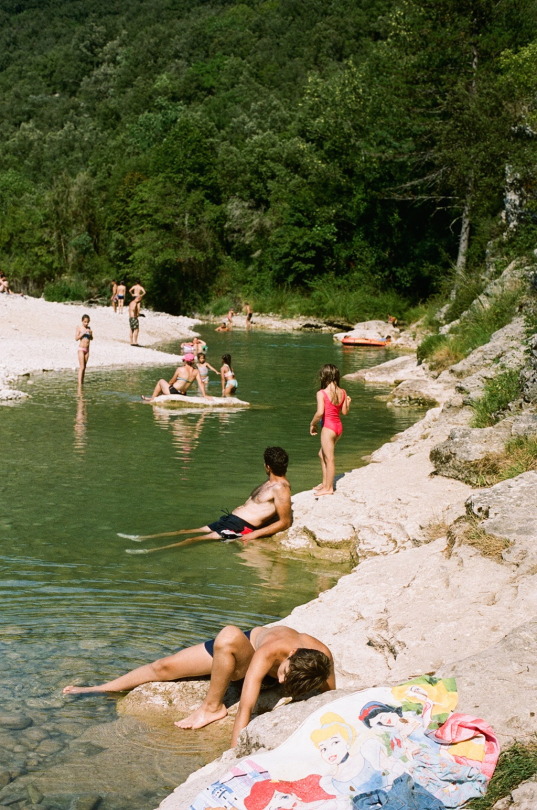
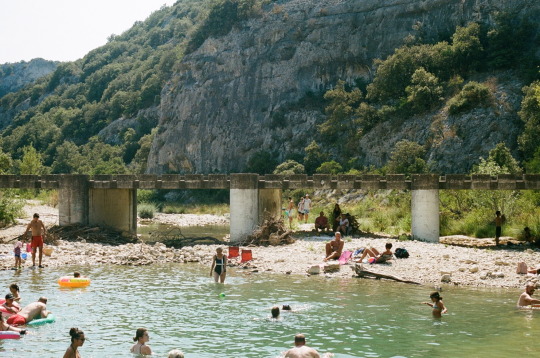
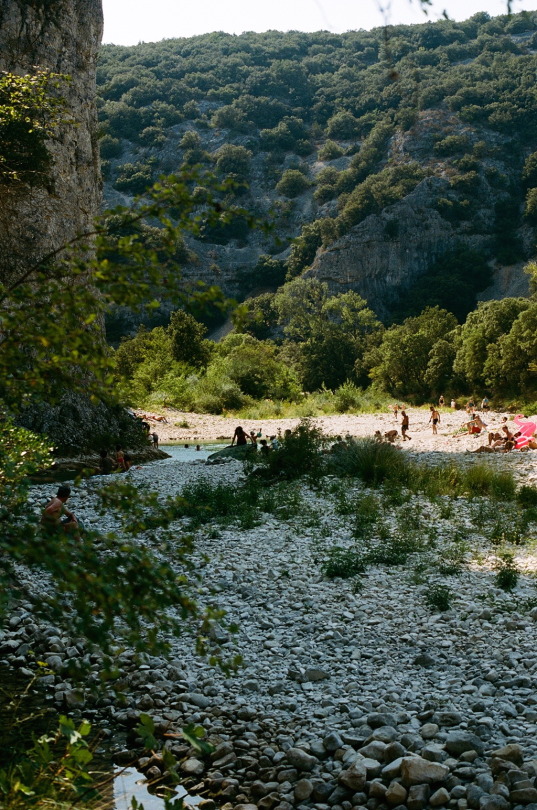
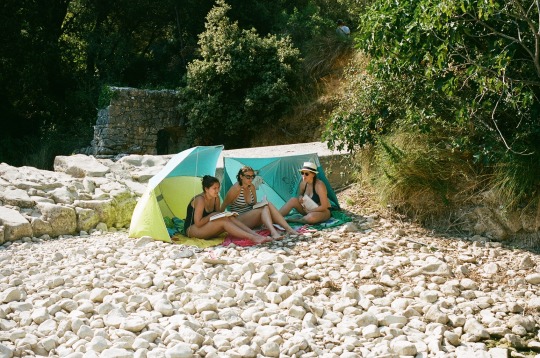
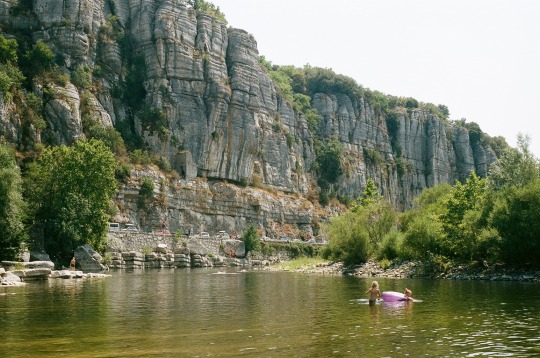
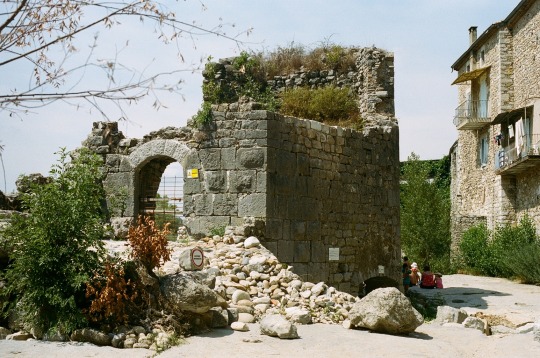

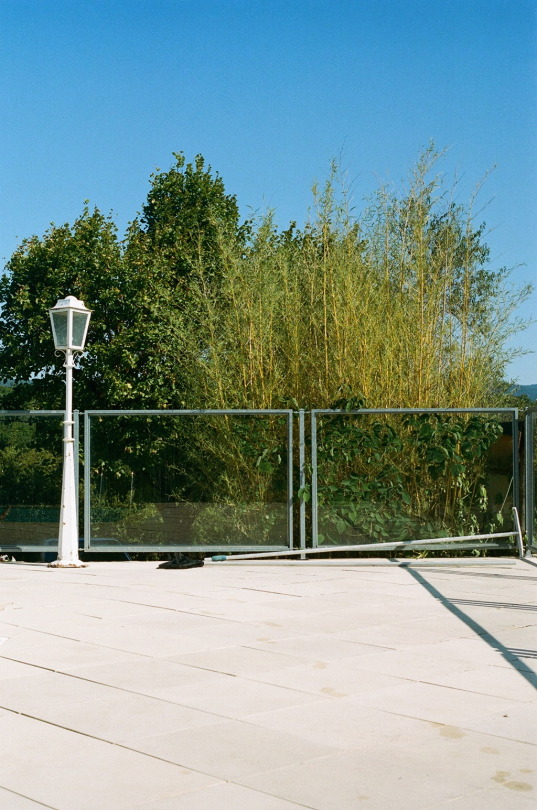
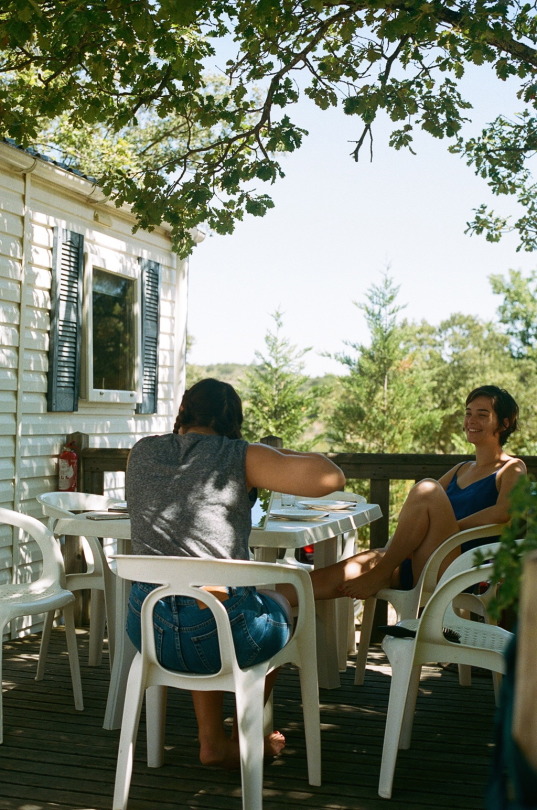
Ardèche, France
(August 2019)
#france#ardèche#summer 2019#countryside#summer holiday#swimming#river#film#film photography#analog#summer#friends#olympus om10#places
4 notes
·
View notes
Photo
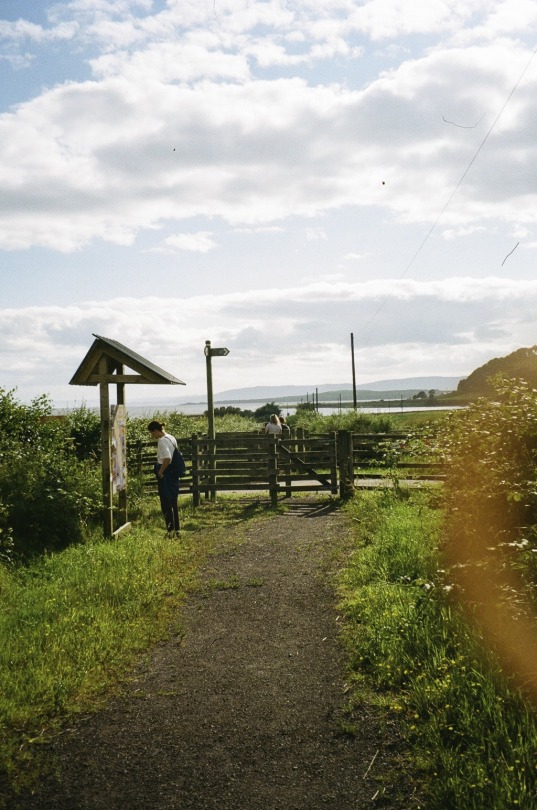
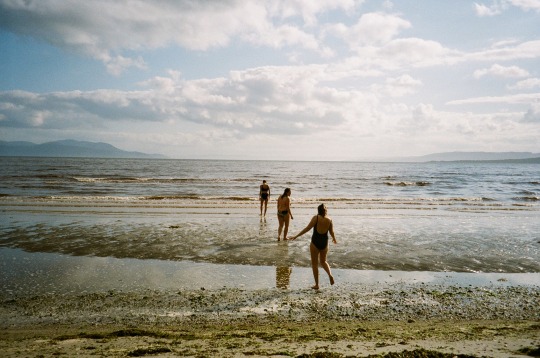
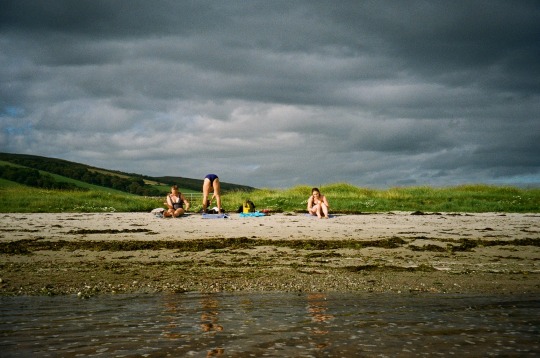



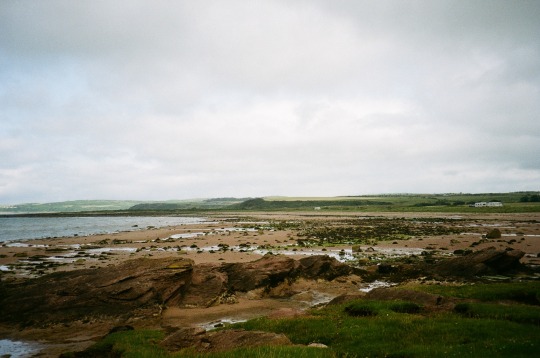
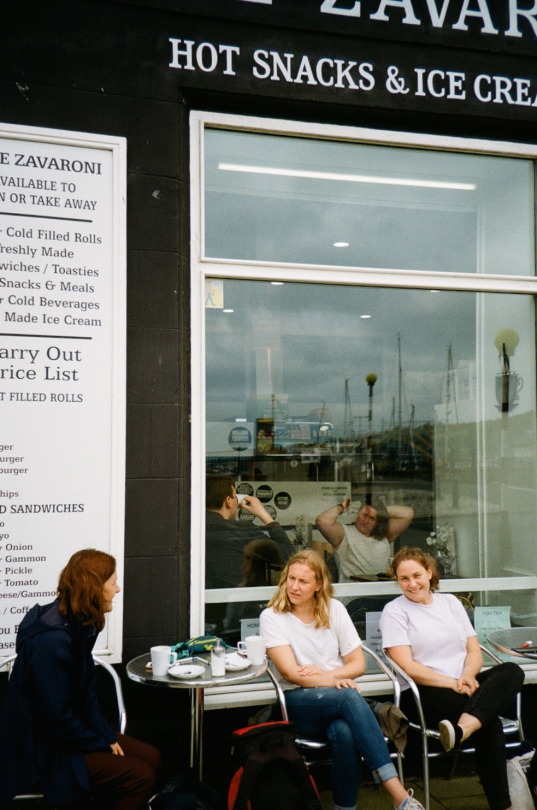
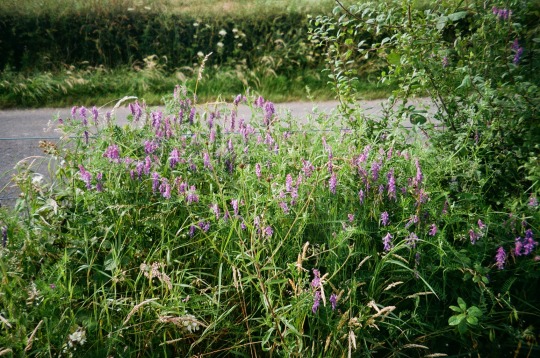
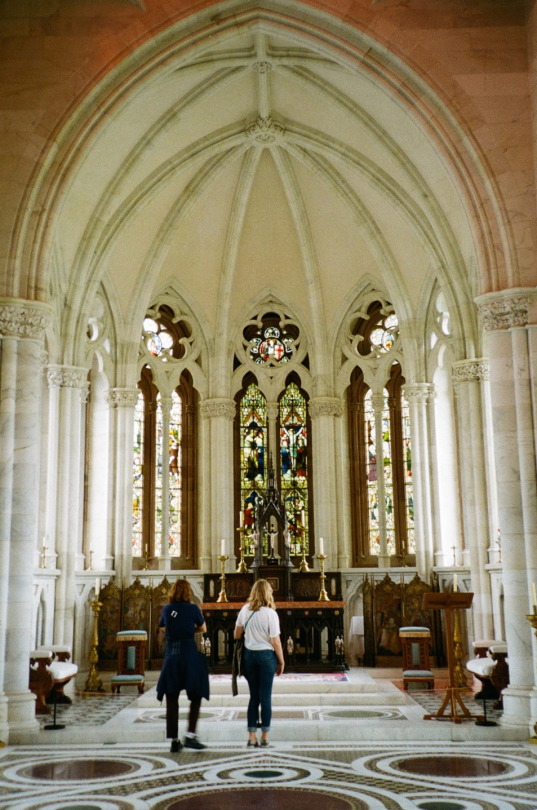
Two days on the Isle of Bute, where the sky is all the seasons and we surrendered to the sea, even when it bit us cold. Summer in Scotland means getting into the water swiftly and swimming for as long as you can, if you can. It’s also walks around the island, along the rocky shores dressed with seaweed and jellyfish. It’s visiting royal grounds where the echoes of colionalism resonate everywhere still. And it’s humbly eating ice cream sandwiches on the peer.
(July 2019)
#july 2019#scotland#isle of bute#analog#film#film photography#summer#nature#seaside#beach#walks#friends#swimming#sea#trips#traveling#2019#countryside#olympus mju iii#places
1 note
·
View note
Text
anselm kiefer
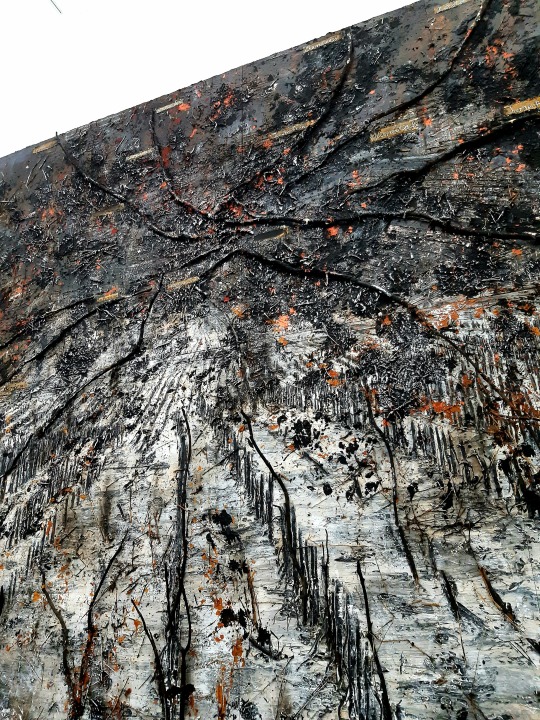
Derelict landscapes are brought to life on the vast surface of the canvas, thanks to textured layers of paint and wood that lose their volumes. They look flat but their impact is far from deflated. Meanwhile, under large glass coffins, rope sculptures expose the transformation of matter. Mesh is cord is paint is root. Twice manipulated, raw material is at once presented and represented.
So go my impressions of Anselm Kiefer’s artworks, as I take them in at the White Cube Gallery. On an afternoon spent walking around Bermondsey, I wander in spontaneously, and discover an exhibition that makes me reflect on the dual energies of the artificial and the natural, on our impulse to intellectualise and systematise our environment, and on the limits of my perceptions.
As you enter the gallery, the large corridor facing the entrance is lined with under-glass sculptures. They remind me of roots, ties underneath the earth that feed and hold the ground together. But they are entangled in wire, paint, plastics. They vary in colour, as if their organic state had been altered. Protecting them from the contact of the visitor, their glass cases are at times adorned with mathematic formulas and hand drawn representations of the roots’ shapes and pathways. I spend a long time going from case to case, deciphering all the tenuous differences introduced in each new piece.
Branching out from either side of the corridor, the wide open rooms of the White Cube host a second series of artworks, landscape paintings of impressive scales. Several meters tall, Kiefer’s pieces are a blend of representation and collage. They depict a nature that was spoiled, a horizon that is at once abundant and easy to take in as one. Yet looking at them is a twofold experience. From afar, the human eye sees the painting as a landscape; wheat in the wind, the ruin of a secluded amphitheatre, an empty field under dirty snow. It absorbs the contrasts of light and shade, the feeling that the art bluntly conveys. It notices the hieroglyphs and runes, traces of thoughts that carry indecipherable meaning. It embraces shapes, perspective, the chaos of objects and symbols colliding on the picture. Meanwhile, from up close, a whole new truth is unraveled. Objects break the surface of the canvas; axes, chains, mesh and stone. Wooden branches stretch out of the surface and into space, differently curved than the nature they serve to depict. Suddenly, the representation is given a concrete shape, within physical touch. The stages of manipulations at play to create the illusion are revealed.
As I make tentative steps towards the art, it strikes me that to focus on a splinter of the piece is to understand its purpose better. That the abundance of details on the canvas reduces but also simplifies my broad vision. That as I watched the roots under the glass earlier, I was again aware of layered meaning, craftsmanship, and representation. I become appreciative of my ability to both see the object as an aesthetic vision, and to look into it beyond representation.
I also realise that it is my impulse to give meaning to the art. To understand what I am presented, look for patterns and systems of thoughts to unpack what I observe. I become conscious of my own mental reflexes, and they remind me of the other linguistic elements I see laid out before me. Runes, hieroglyphs, algorithms; all human-made mechanisms to intellectualise the world we inhabit and a nature we haven’t chosen. All here to explain us to us. Our need to change our environment, to shape it into something befitting of our desires and intentions. Our instinct to put words and implications into what surrounds us, to give it all meaning, so that life itself gains purpose.
Standing in the boundless white space of the gallery, I inhale and take stock of the emotions that Anselm Kiefer has so seamlessly lodged in my heart and mind on that January afternoon. And it’s as if the branches had bent out far beyond the painting, and tangled me in.
(Until January 26th 2020 @ the White Cube Bermondsey, London)
#art#review#art review#anselm kiefer#anselm kiefer review#white cube bermondsey#london#gallery#museum#museum experience#aesthetics#representation#philosophy of art#nature vs artificial#art guide#artist#contemporary art#modern art#visual art#painting#moment of beauty#winter 2020#january 2020
37 notes
·
View notes